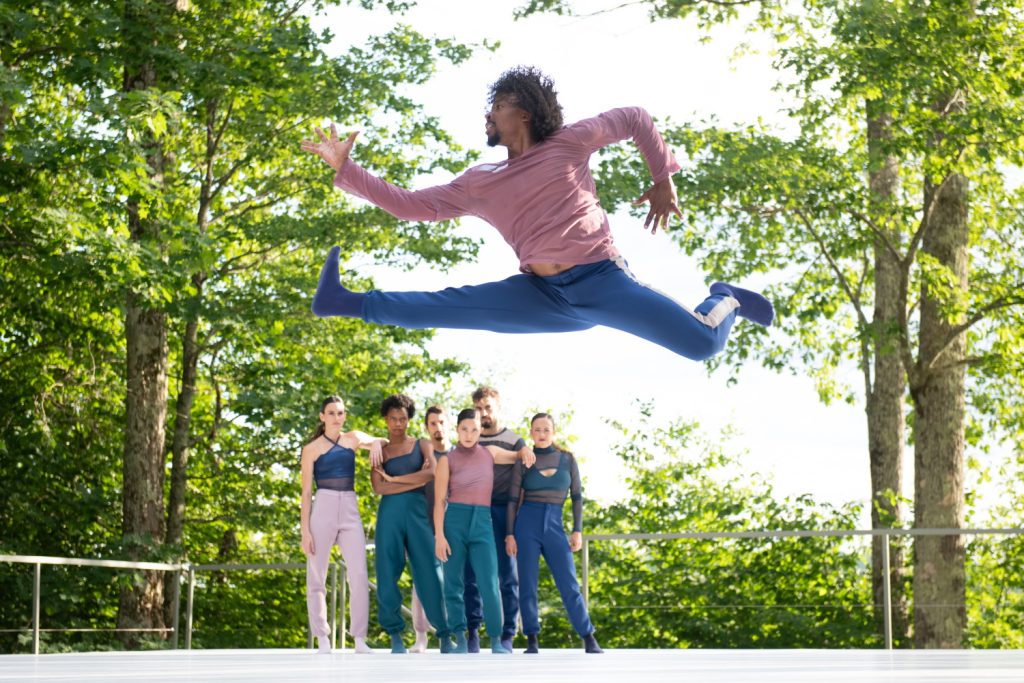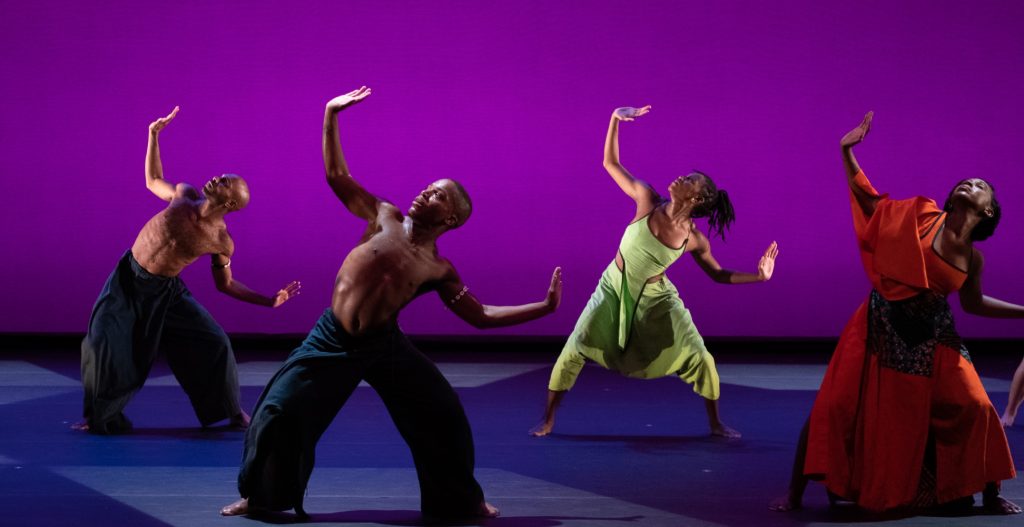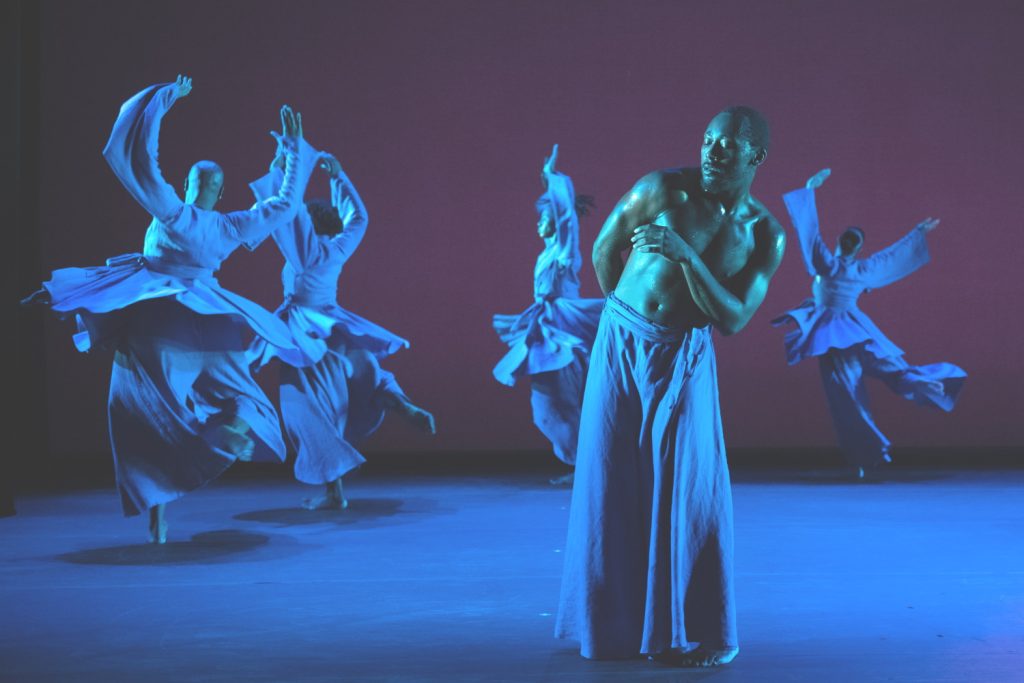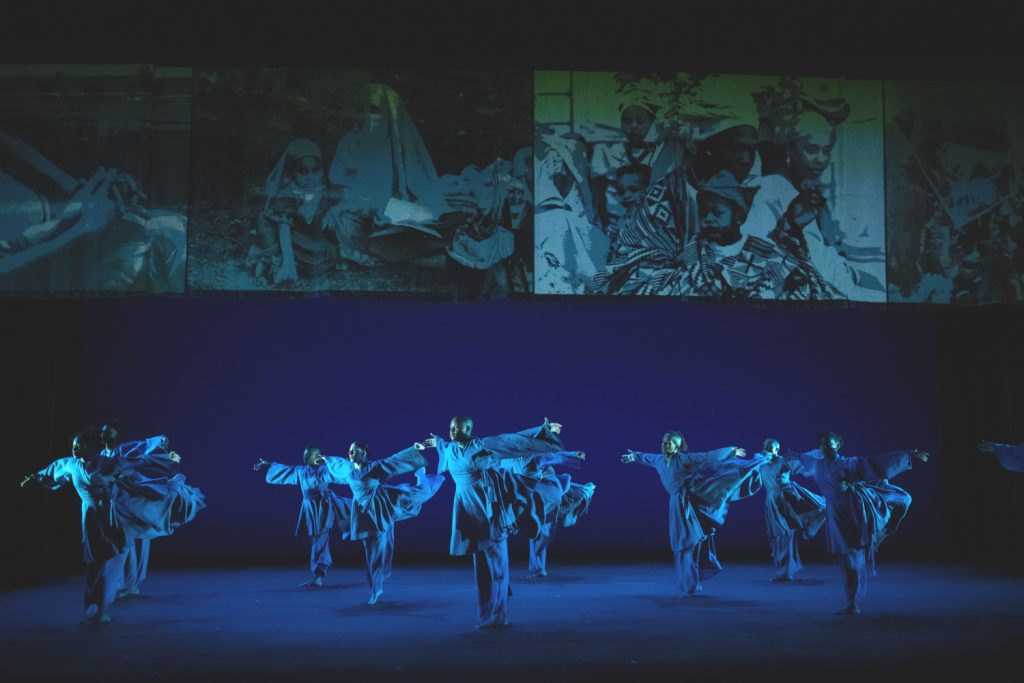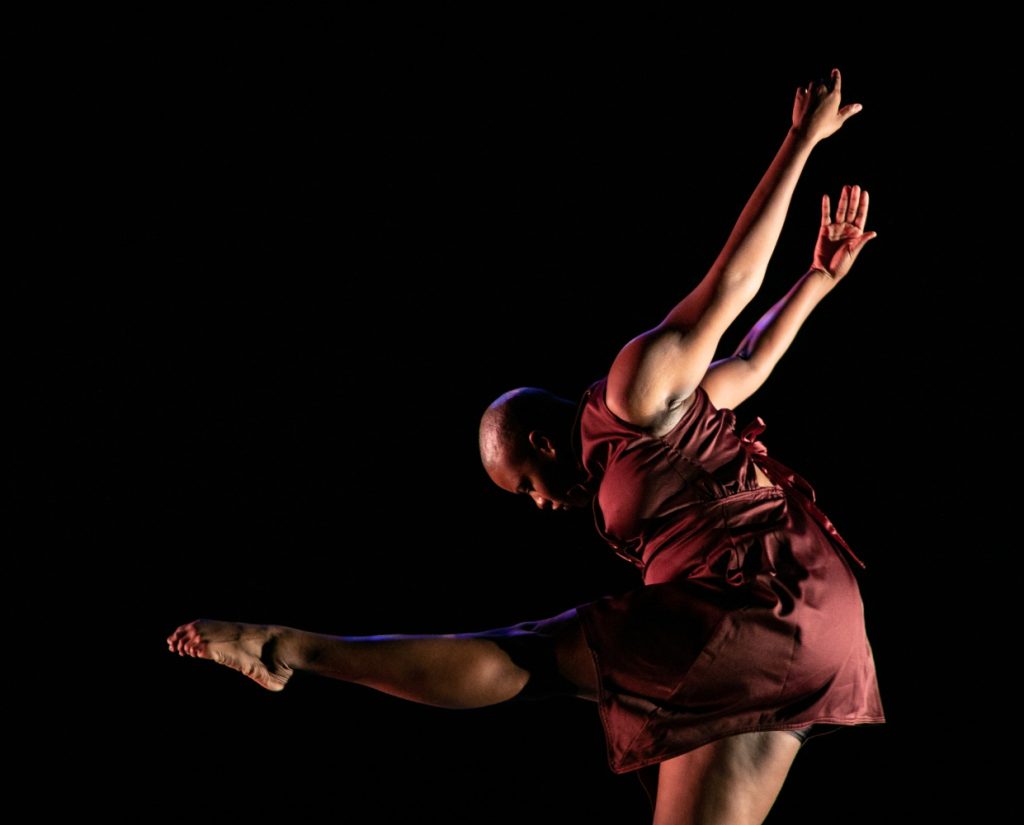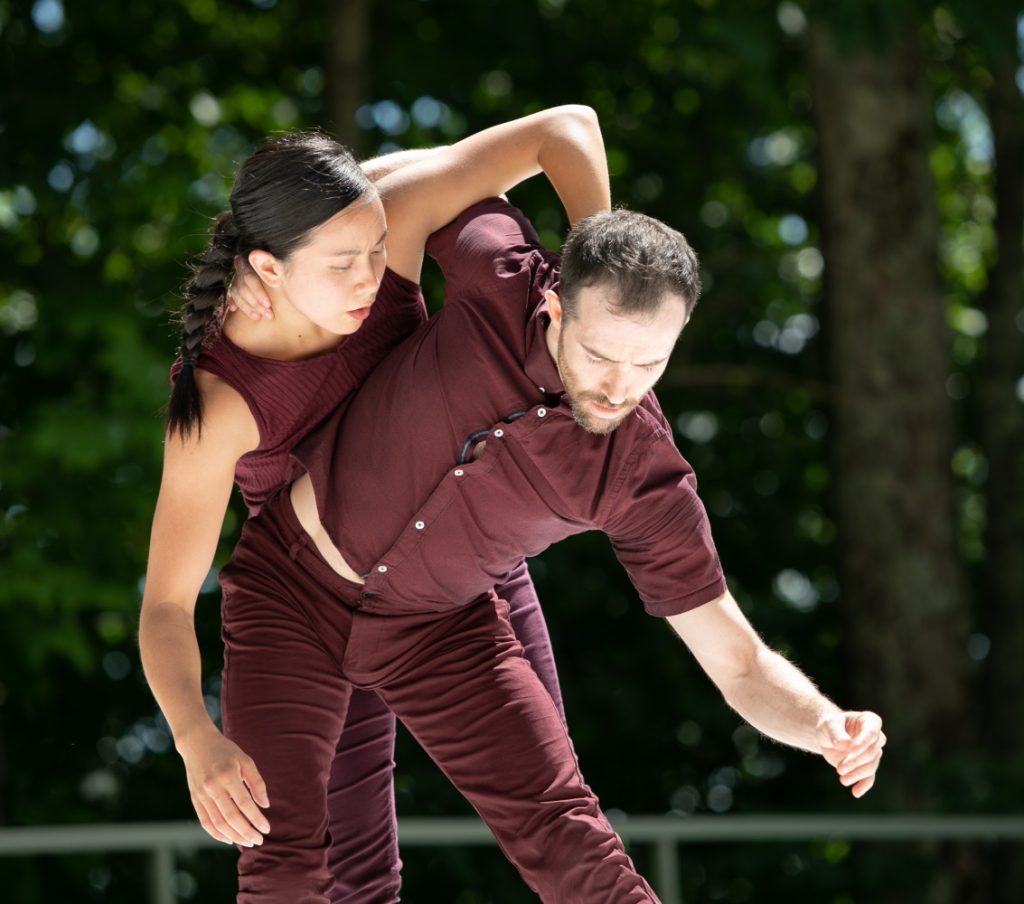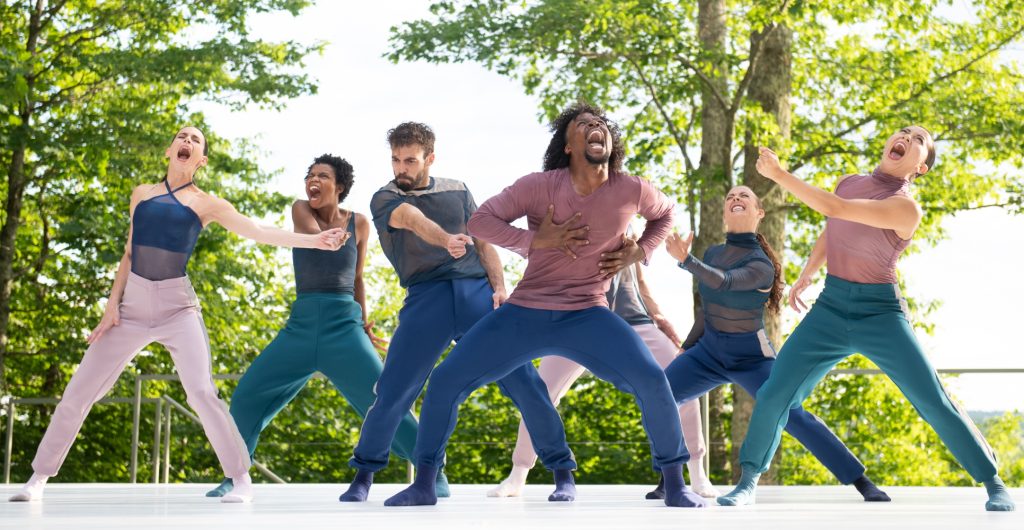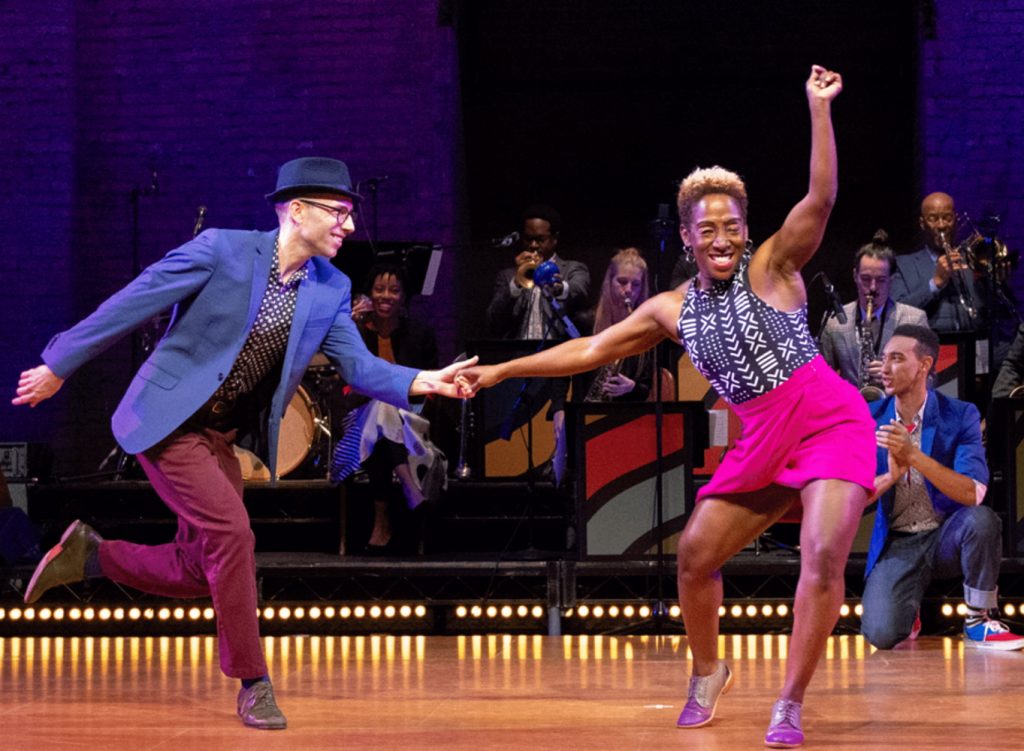The Covid Era has been a bad-news/good-news time for Jacob’s Pillow Dance Festival. Bad news: On top of being shuttered by the pandemic, in late 2020 the Doris Duke Theatre, the company’s cozy second stage, burned to the ground in an unexplained fire. Last summer and again this year, some performances that otherwise would have been in the Duke moved to the Pillow’s outdoor platform stage.
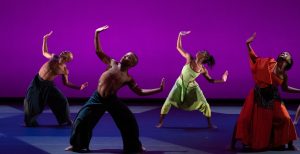 The good news (in the glass half-full sense, anyway) is that the shutdown allowed the festival to begin long-overdue renovations in the Ted Shawn Theatre, the huge barn of a building that anchors the campus, named for the festival’s visionary co-founder. Now it’s open, and to the casual eye mostly unchanged – the same deep and wide auditorium with its rough-hewn walls and cathedral heights, but without the big character portraits of Shawn and his co-founder wife, Ruth St. Denis, that used to flank the proscenium. The modern world has been applied to technical aspects, including the most eagerly awaited update, air conditioning – which, on opening night of the season’s second week, was still experiencing “difficulties.”
The good news (in the glass half-full sense, anyway) is that the shutdown allowed the festival to begin long-overdue renovations in the Ted Shawn Theatre, the huge barn of a building that anchors the campus, named for the festival’s visionary co-founder. Now it’s open, and to the casual eye mostly unchanged – the same deep and wide auditorium with its rough-hewn walls and cathedral heights, but without the big character portraits of Shawn and his co-founder wife, Ruth St. Denis, that used to flank the proscenium. The modern world has been applied to technical aspects, including the most eagerly awaited update, air conditioning – which, on opening night of the season’s second week, was still experiencing “difficulties.”
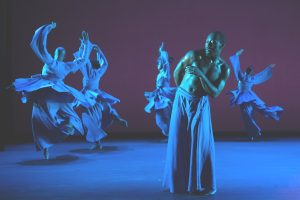 Last week, the big hall hosted the world premiere of a work that was supposed to be part of the canceled 2020 season, by the Ronald K. Brown/EVIDENCE dance company. Evidence, that is, of faith in the unseen, including ancestral spirits, and of suffering, endurance and ultimate victory, expressed by bodies in motion. Brown’s work, which dates back to the 1980s, incorporates influences from the African diaspora and takes inspiration from Black people’s struggles and aspirations. From the evidence of last week’s program – my first encounter with this longtime Pillow favorite – the diasporic influences were not at the fore.
Last week, the big hall hosted the world premiere of a work that was supposed to be part of the canceled 2020 season, by the Ronald K. Brown/EVIDENCE dance company. Evidence, that is, of faith in the unseen, including ancestral spirits, and of suffering, endurance and ultimate victory, expressed by bodies in motion. Brown’s work, which dates back to the 1980s, incorporates influences from the African diaspora and takes inspiration from Black people’s struggles and aspirations. From the evidence of last week’s program – my first encounter with this longtime Pillow favorite – the diasporic influences were not at the fore.
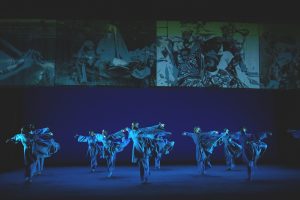 Social/political themes, though, were abundantly present in the new work, titled The Equality of Night and Day. Projections on hanging banners documented worldwide social-justice movements, and much of the soundtrack consisted of excerpts from speeches by Angela Davis. (“How do we imagine and struggle for a democracy that does not spawn forms of terror?”) Those orations alternated with original music played live by composer/pianist Jason Moran, some of it drawing on pieces by John Coltrane and Thelonious Monk.
Social/political themes, though, were abundantly present in the new work, titled The Equality of Night and Day. Projections on hanging banners documented worldwide social-justice movements, and much of the soundtrack consisted of excerpts from speeches by Angela Davis. (“How do we imagine and struggle for a democracy that does not spawn forms of terror?”) Those orations alternated with original music played live by composer/pianist Jason Moran, some of it drawing on pieces by John Coltrane and Thelonious Monk.
For all the audio/visual substance, I found it hard to connect it to the onstage movement, which seemed independent of, and sometimes at odds with its context. The ensemble’s movements and flowing costumes kept reminding me of whirling dervishes, and a concluding ritual in which the dancers laid their clothes in a pile on the floor gave the impression of sacred offerings, but to what?
One repeated episode in the piece – a soloist surrounded by a slowly moving circle of dancers – struck home, if you knew its meaning. A pre-show PillowTalk explained that it derived from the mourning ceremony of African elephants, who form a loving and supportive circle around a dying member. But you had to know that to get it.
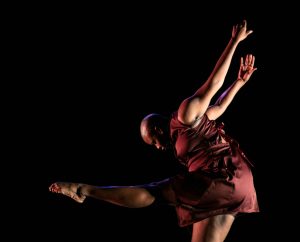 The dancers, though, were sensational. Where the lean, lithe “dancer’s body” is still de rigueur in most quarters, not all of Brown’s troupe matches the template – especially tall, substantial Joyce Edwards, whose energy, focus and nimble majesty drew my eyes every moment she was onstage.
The dancers, though, were sensational. Where the lean, lithe “dancer’s body” is still de rigueur in most quarters, not all of Brown’s troupe matches the template – especially tall, substantial Joyce Edwards, whose energy, focus and nimble majesty drew my eyes every moment she was onstage.
Two works from the ’90s were revived for this program. Gatekeepers and Upside Down, both of them with music featuring the British/Nigerian singer Wunmi Olaiya, traced progressions of life and death from African and Native American traditions. But again, you needed advance knowledge to interpret the action.
Traffic Jam
For me, the evening’s most satisfying show was the second-on-the bill performance by LA-based BodyTraffic. It was on the outdoor Henry J. Leir Stage, the former Inside/Out space, perched on a gently sloping hillside overlooking a wooded valley, upgraded (and renamed) last year, with actual seating instead of scattered boulders and lawn chairs.
Three short works with very different soundtracks showcased the company’s versatility and showed off its chops. Tina Fickelman Berkett’s troupe works with a variety of guest choreographers, and the pieces reflected the dancers’ individual styles and choices, a showcase of soloists working in concert.
Matthew Neenan’s A Million Voices featured a handful of tracks by the 40s-50s jazz-pop star Peggy Lee. The songs ranged from classics like “Blues in the Night (My Mama Done Told Me),” with the Benny Goodman band, to “Freedom Train,” a patriotic duet with Bing Crosby. The choreography created abstract reflections on the jazz rhythms.
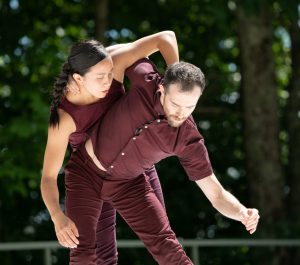 Notes on Fall, choreographed by Brian Brooks, was a pas de deux with dancers Tiare Keeno and Guzmán Rosado, set to piano pieces by Leoš Janáček. The couple’s graceful interaction reminded me of contact improv, responding to each other’s gesture and touch. For my companion, “It was as if they were embracing the earth, yielding to it as a third partner in the dance.”
Notes on Fall, choreographed by Brian Brooks, was a pas de deux with dancers Tiare Keeno and Guzmán Rosado, set to piano pieces by Leoš Janáček. The couple’s graceful interaction reminded me of contact improv, responding to each other’s gesture and touch. For my companion, “It was as if they were embracing the earth, yielding to it as a third partner in the dance.”
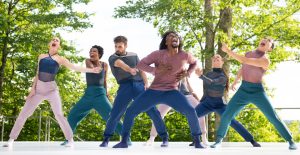 Snap, set by Micaela Taylor, was based on clever samples and deconstructions of James Brown tracks edited by SHOCKEY. The most literal – and of course funky – of the pieces, it pounced on lines like “And after man make everything / You know that man makes money to buy some other man,” from “It’s a Man’s Man’s World,” to recreate edgy moments from the LA streets. Ty Morrison took center stage for much of it, bringing an explosive hip-hop feel.
Snap, set by Micaela Taylor, was based on clever samples and deconstructions of James Brown tracks edited by SHOCKEY. The most literal – and of course funky – of the pieces, it pounced on lines like “And after man make everything / You know that man makes money to buy some other man,” from “It’s a Man’s Man’s World,” to recreate edgy moments from the LA streets. Ty Morrison took center stage for much of it, bringing an explosive hip-hop feel.
Coming Up
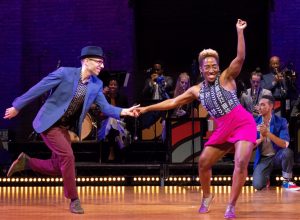 Next up, July 6-10, the mainstage is taken over by period and contemporary jive, in the hands – or rather feet – of SW!NG OUT (that’s not a typo). It’s a swing-dance jamboree created by choreographer Caleb Teicher, with live music by the Eval Vilner Big Band.
Next up, July 6-10, the mainstage is taken over by period and contemporary jive, in the hands – or rather feet – of SW!NG OUT (that’s not a typo). It’s a swing-dance jamboree created by choreographer Caleb Teicher, with live music by the Eval Vilner Big Band.
It’s accompanied on the Leir Stage, Wednesday-Saturday, by a series of one-night stands by a variety of companies: JazzAntiqua, described as “celebrating jazz as a vital thread in the cultural fabric of African American history and heritage”; Prakriti Dance, which “uses the movement vocabulary of Indian classical dance to transcend cultural boundaries”; the boundary-busting Bill Shannon, performing hip-hop and skateboarding on crutches; and The New York Korean Performing Arts Center, “dedicated to promoting an understanding and appreciation of Korea’s artistic heritage and history.”
Visit jacobspillow.org for tickets and info.
Photos by Christopher Duggan
Featured image (BodyTraffic) by Jamie Kraus
In the Valley Advocate’s present bi-monthly publication schedule, Stagestruck will continue to be a regular feature, with additional posts online. Write me at Stagestruck@crocker.com if you’d like to receive notices when new pieces appear.
Note: The weekly Pioneer Valley Theatre News has comprehensive listings of what’s on and coming up in the Valley and beyond. You can check it out and subscribe (free) here: http://www.pioneervalleytheatre.com/
The Stagestruck archive is at valleyadvocate.com/author/chris-rohmann
If you’d like to be notified of future posts, email Stagestruck@crocker.com

